| Joseph Janney: Leesburg Businessman and Developer of the Village of Waterford, VA |
||||||||||||||||||||||||||||||||||||||||||||||||||||||||||||||||||||||||||||||||||||||||||||||||||||||||||||||||||||||||
|
by Debbie Robison May 23, 2021 | ||||||||||||||||||||||||||||||||||||||||||||||||||||||||||||||||||||||||||||||||||||||||||||||||||||||||||||||||||||||||
|
Joseph Janney, a Quaker born in Pennsylvania, established the village of Waterford on a 12-acre parcel of land he purchased in 1781.[1] His land included a dwelling house situated atop a hill overlooking a grist mill and sawmill owned by his sister-in-law’s brother, Mahlon Janney.[2] At the base of the hill, a dirt road sloped gently down to the mills. A small branch, cutting diagonally across the land as it makes its way to South Fork Catoctin Creek, remains as part of the cultural landscape providing a reminder of early industrial endeavors in Waterford. Janney’s development of this land provided him with a steady income through the rental of lots. But more importantly, the availability of lots for lease was a boon to people who did not have the advantage of land ownership, such as merchants and craftsmen. Neighboring farmers who sought other business opportunities also benefited. 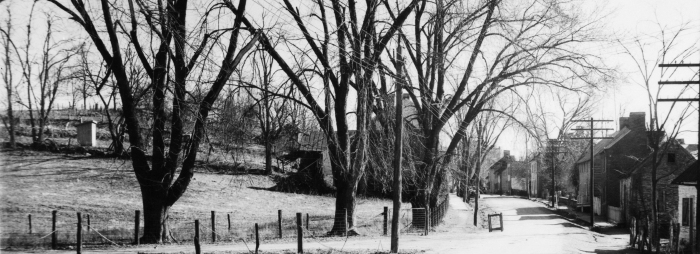
Joseph Janney’s Land at Waterford, Portion
of HABS Photo, Post-1933, Town of Waterford (General Views), Courtesy Library
of Congress | ||||||||||||||||||||||||||||||||||||||||||||||||||||||||||||||||||||||||||||||||||||||||||||||||||||||||||||||||||||||||
| EARLY BUSINESSES VENTURES | ||||||||||||||||||||||||||||||||||||||||||||||||||||||||||||||||||||||||||||||||||||||||||||||||||||||||||||||||||||||||
|
Throughout his life, Janney was involved in numerous and varied business ventures. Like most of his neighbors, he was a farmer. In 1758, he received 200 acres from his father “under the southeast side of the Short Hill” near present-day Hillsboro.[3] But it was in the new town of Leesburg where Janney established himself as a businessman. In 1758, he purchased lot #4 on the prominent corner of King and Loudoun Streets where he and Joseph Hough may have had their store. The lot also contained Joseph Janney’s Leesburg stable. [4] Janney must have also had some association with the cooper trade (wooden barrel making) since a fifteen-year-old boy was apprenticed to him by the county churchwardens in 1764 to learn the trade of cooper.[5] The following year the boy, along with two females, were found guilty of stealing money from Janney and Hough.[6] 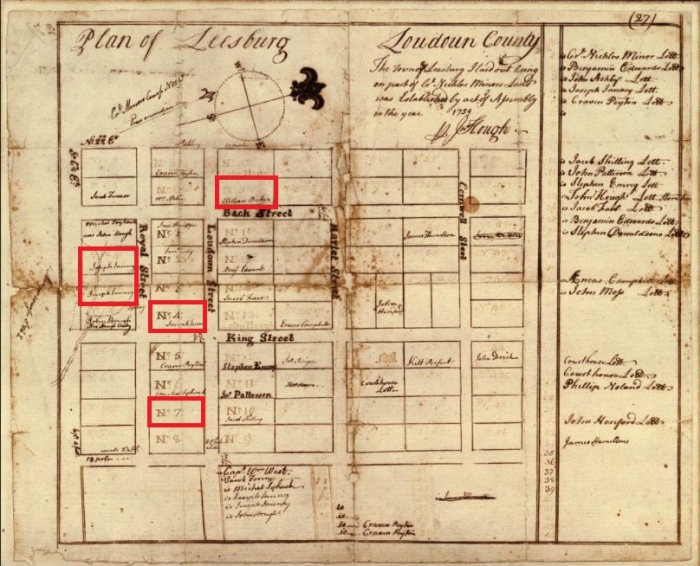
Joseph Janney Leesburg Lots as shown on the Plan of Leesburg, Drawn by John Hough, Courtesy Loudoun County Clerk of the Circuit Court Archives, Loudoun County Office of Mapping and Geographic Information, Click on Map for Larger Image
×
Janney also likely formed a business partnership with Mahlon Taylor, as they were frequently in court together suing for the collection of debts.[7] The location of the business is unknown, though Janney did acquire Leesburg lot #58 in 1764 and lot #7 in 1765.[8] Another business Janney started in Leesburg was a tannery. In 1767, he purchased a 2 1/4-acre lot that included Leesburg lot #64.[9] This land had a branch running through it, which was an essential resource since water is required during the leather tanning process. Janney operated his tannery business in partnership with Martin Werts, though Janney had the upper hand. Werts was not to buy, sell, or receive anything without the approval of Janney.[10] In 1773 the churchwardens apprenticed a 9-year-old boy to Janney to learn the trade of a tanner and currier.[11] | ||||||||||||||||||||||||||||||||||||||||||||||||||||||||||||||||||||||||||||||||||||||||||||||||||||||||||||||||||||||||
| ESTABLISHMENT OF WATERFORD | ||||||||||||||||||||||||||||||||||||||||||||||||||||||||||||||||||||||||||||||||||||||||||||||||||||||||||||||||||||||||
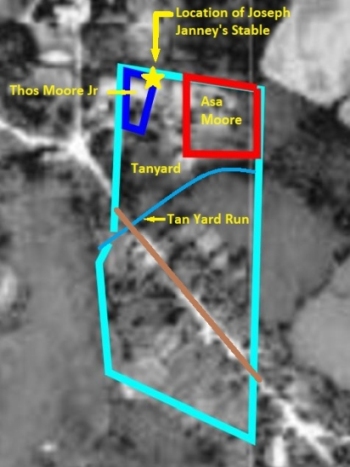
The Portion of Joseph Janney Land Developed into a Village, Shown Over 1937 USDA Aerial photo. Aerial Photo Courtesy Loudoun County Following the Revolutionary War, Janney turned his attention to developing the 12-acre parcel he bought during the war. He developed his land in two phases. He first sold and leased lots on the north side of the road that passed through his land, and five years later leased lots on the south side of the road. One family who made significant contributions to the growth of the village was the Moore family. Thomas Moore Sr. and his three adult sons (James, Thomas Jr., and Asa) operated mercantile and manufacturing businesses. Manufacturing included saddle making, tanning, and cabinet making. Of Note: The earliest known explanation given for how Waterford acquired its name was in 1860 when William Williams read a history of the town before the Waterford Literary Society. Williams suggested that the Moore family hailed from Waterford, Ireland and named the village after their homeland.[12] The family lineage has not, as yet, been traced to Waterford, Ireland to confirm this tradition.
Thomas Moore & Co. In 1784, Joseph Janney was getting ready to start a new business as a wholesale merchant. He partnered with two men from Philadelphia to purchase part of a lot in Alexandria.[13] He received imports from London in the ship “the Friends” (a nod to the Quaker’s Society of Friends) and sold a general assortment of merchandise to retail merchants, advertising that his prices were low since most goods were shipped by manufacturers.[14] This business venture was well timed. The American economy enjoyed five years of maritime commerce prosperity after the Revolutionary War due to no longer having British trade restrictions. Thomas Moore, Jr. Store and House, National Park Service Photo, 1969, Courtesy National Archives It was at this time, in August 1784, that Janney (who was then living in Fairfax County, probably in Alexandria[15]) sold the dwelling house on the hill to Thomas Moore Jr., a fellow Quaker.[16] The deed mentions the dwelling house and pinpoints the location of Joseph Janney’s stable. This was the first lot sold in the new village. Thomas Moore Jr. entered into the mercantile business with John Sutton, an established merchant in Alexandria.[17] Moore’s store was in operation in 1784.[18] He borrowed £100 from Sutton and used the house and lot as collateral on the loan. It is unknown if Thomas Moore Jr. used these funds to build the stone addition to the house for use as the store. All that is known for certain is that the stone addition existed by 1803.[19] While the start of Joseph Janney’s maritime commerce business was well timed, the start of Thomas Moore Jr.’s store was not. America entered into a five-year postwar depression beginning the year Moore opened the store.[20] Sometime in the year 1787, the partners of the store decided to stop selling goods on credit. Accordingly, they closed their books except for a small memorandum book in which they entered “some trifles” that were to be settled in a few days. A few months later, though, they decided to give credit to a few customers and take their notes (promises to pay) for the amount of the goods.[21] These business financial decisions highlight the difficulties merchants had during the post-war depression. The business, operating as Thomas Moore & Co., lasted until about 1790 when Thomas Moore, Jr. moved to Maryland.[22] Receipt from Thomas Moore & Co for
payment in wheat, [23] Courtesy Loudoun County and Library of Virginia Asa Moore and James Moore, Thomas’s brothers, also helped with the store by sometimes collecting debts and issuing receipts. 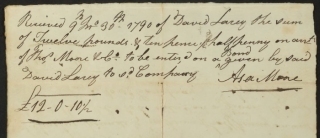
Asa Moore's Receipt [24] 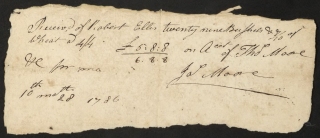
James Moore's Receipt [24]
Thomas Moore, Jr.’s parents lived with him for a time.[25] They may have continued to live in the house after Thomas Moore Jr. moved to Maryland. When Thomas Moore, Sr. died in 1799, the house was sold to Asa Moore.[26] The Tannery Former Tannery Location, Corner of Main and Liggett Streets Joseph Janney, experienced in the tanning and currying trade in Leesburg, would have recognized the opportunity he had with a branch running through his Waterford property. He established a tannery along this branch that he leased to James Moore.[27] The tanyard was established by 1785, and the branch became known as Tan Yard Run.[28] The tannery lot extended across three quarters of an acre of land and included a house where James Moore would come to live.[29] The tanning process involved soaking animal hides in vats dug into the ground. Hides were first soaked in water, then alternated between soaking in vats containing lime in water and being set out to dry. This loosened the hair so the tanner could remove the hair and fat for sale to a plasterer. The cleaned hides were placed in a pit in alternating layers with the bark from trees having a high tannin content, such as oak and chestnut. This process softened the leather. Once removed from the pit, an alkaline solution was rubbed over the hides to stop the acidic tanning process. It was now the currier’s turn to apply oils to the hides. [30] The labor to operate the tannery businesses came, in part, from churchwardens and Overseers of the Poor who apprenticed boys to James and Asa Moore, and later the firm of Moore & Phillips, to learn the tannery trade.
Apprentices Bound to the Moores to Learn the Tanner and Currier Trades
In 1787, two apprentices ran away and an advertisement was posted in the newspaper. The advertisement is interesting because it shows that the village is being called Waterford by this time. RAN away from the Subscribers in November
last, two apprentice lads, one named WILLIAM RIGNEY, about 18 years of age, 5
feet 8 inches high: He had on and took with him one cloth coat, one fustian
waistcoat, two shirts, two pair of trousers, one pair of stockings and one pair
of shoes. The other named MORGAN HOGE, about 20 years of age, 5 feet 10 inches
high: He had on and took with him two suits of apparal.
Whoever takes up said lads and brings them to their masters again, shall be
entitled to a reward of TWO SHILLINGS and SIX-PENCE, or in proportion for
either of them. JAMES MOORE, JOHN COFFEE. Waterford, Loudon County, Jan. 1,
1787 [43] Joseph Janney continued to lease the tannery to James Moore until Janney’s death in 1792.[44] Janney’s heir sold the tannery to Asa Moore in 1796. [45] Asa Moore went into partnership with Thomas Phillips and the business operated as Moore & Phillips. When the business was dissolved, the personal property was sold in 1823. It included an extensive collection of tanned and partly-tanned soal leather; upper, skirting, and calf skins; currying tools, and between 100 to 200 cords of bark.[46] When the real estate of the business was advertised for sale in 1832, the improvements consisted of a large bark house, currying shop, handling house, and 40 to 50 vats. The sale included an adjoining lot on the main street with a brick store house and small dwelling.[47] The Saddlery Asa Moore operated a saddle manufacturing business.[48] His trade complemented the tanning business since he would have had a ready source of leather for making saddles. He obtained apprentices to learn the saddler trade. Asa Moore purchased a one-acre lot from Joseph Janney in 1791 located in the northeast corner of Janney’s 12-acre parcel.[49] The location where the saddlery business operated is unknown. Apprentices Bound to Asa Moore to Learn the Saddler Trade
Cabinet Makers The records of apprenticed youth also suggest that Thomas Moore (Senior or Junior) operated a cabinet making business. A cabinet maker constructed furniture, such as cupboards, drawers, doors, and coffins. Two of the apprentices were to learn the cabinet maker trade. Another two apprentices were to learn the trade of a joiner. Joints, such as dovetail joints, were constructed by this tradesman to connect pieces of wood together. Apprentices Bound to Thomas Moore to Learn the Cabinet Maker and Joiner Trades
Some of the people who worked and lived with the Moores later set up shop in the village once opportunities became available. | ||||||||||||||||||||||||||||||||||||||||||||||||||||||||||||||||||||||||||||||||||||||||||||||||||||||||||||||||||||||||
| LOT DEVELOPMENT | ||||||||||||||||||||||||||||||||||||||||||||||||||||||||||||||||||||||||||||||||||||||||||||||||||||||||||||||||||||||||
|
Location of Lots on North Side of Road, Plotted Over 1937 USDA Aerial Photo, Refer to Legend Below In 1785, Janney created lots along the north side of the road where buildings were constructed into the hillside. Two half-acre lots were sold: one to Richard Richardson and the other to Joseph Pierpoint, Richardson’s nephew. The remaining lots on the north side of the road were leased (except for the small lot labeled F that wasn’t developed until Janney’s heirs sold the lot).
A:
Richardson’s Lot Richard Richardson, whose lot bordered Tan Yard Run, did not move to the village.[60] He lived on his farm in Maryland.[61] It is unknown what use he made of the lot, though it did have a building.[62] One remote possibility is that Richardson operated a tavern. The only hint is a reference in the Friends Meeting Minutes that his daughter was married at “Richardson’s House.”[63] At this time, the term house typically referred to a tavern (unless prefaced with store, i.e., store house). After Richardson’s death in 1802, the lot was divided in half. His son, William Richardson, inherited the western half.[64] By 1810 the lot was owned by Moore & Phillips, the firm that owned the adjacent tannery.[65] The business operated a store on the lot in a brick store house.[66] There was also a small dwelling on the store lot.[67] For many years the store house lot was owned by the tannery owner(s).[68] Building that Existed on the Store House Lot in the 1930s, Age of Structure Unknown, HABS photo, Courtesy Library of Congress 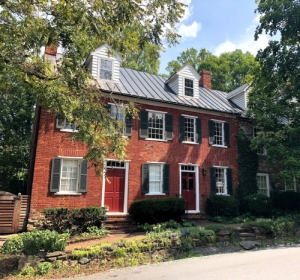
Francis Pierpoint, Richardson’s brother-in-law, purchased the eastern half of Richardson’s lot. His son, Samuel Pierpoint, may have operated a retail store on the lot.[69] The lot was further subdivided in 1809 when Samuel purchased the western half of his father’s portion of the lot.[70] Samuel likely built the existing brick building in 1812 for use as a store/dwelling just before he died.[71] Buildings with two front doors were often used for both a commercial and residential purpose. One door led to the business while the other door was used as a private family entrance. Joseph Pierpoint’s Lot 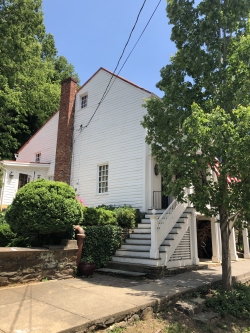
Log Building Likely Constructed for Evan Griffith for use as a Tavern ca. 1796 Joseph Pierpoint, a blacksmith, owned the half-acre lot adjacent to Richardson’s lot.[72] This house was later rebuilt in a Victorian style. Pierpoint sold the eastern half of his lot in 1796 to Evan Griffith, who operated a tavern there.[73] The existing house, constructed of logs (clad with weatherboard) over a stone foundation, was likely built ca. 1796.[74] Leased Lots: North Side of the Road The remainder of the lots along the north side of the road were leased (except for the small lot on the east). Joseph Janney set up an interesting ownership scheme. Here is how that worked: Janney leased the land and collected ground rent. It was up to the people who leased the land to construct buildings. A lease on a lot could be sold to someone else, and this person would pay the value of the buildings to the previous owner of the lease, but Joseph Janney would still be entitled to receive the ground rent. This provided Janney with a continuous income stream. C: William
Paxson’s Leased Lot William Paxson began paying taxes on his leased lot in 1789.[75] This lot was about a quarter acre in size and originally had a log house constructed on it.[76]Paxson was occupying the building for a number of years, though it is not known if it was also occupied as a business.[77] Only the stone foundation of the original building remains. D and E:
Joseph Scott’s Leased Lot and Ann Myers’ Leased Lot The lot east of Paxson was leased by 1786 to Joseph Scott.[78] The existing log structure on this lot likely dates to this period.[79] Scott sold the lease to Benjamin Rickmire ca. 1791.[80] Leases were often not recorded in the deed books, as is the case with this lot. Determining who owned the leases required a bit more sleuthing using land tax ledgers, insurance records, and adjacent property deeds. The trail picks up in 1796 when the heirs of Joseph Janney sold the lot to Andrew Brown.[81] The lot to the east was leased to Ann Myers by 1794.[82] By 1800, Fleming Patterson owned both the Scott and Myers lots. Insurance records show that there were a series of connected buildings on the lots with a kitchen structure behind the easternmost portion of the tenements. 
Kitchen Outbuilding (Portion on Left), Built by 1806, HABS Photo, Courtesy Library of Congress The kitchen was described as being 14’x15’ and constructed of stone on the lower level and log on the upper level. The description and the location exactly match a structure shown in a HABS photo. All that remains now of the kitchen outbuilding is the stone foundation. F: John
Williams’s Lot John Williams purchased this lot, along with an adjacent lot to the east, after Joseph Janney’s death.[83] Leased Lots: South Side of the Road 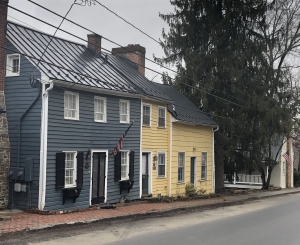
Buildings on Original Lots 14 and 15 Joseph Janney subdivided the land on the south side of the road into 15 lots. All of these lots were leased in 1792 under the condition that Janney receive ground rent. The 15 lots extended from the branch used by the tannery to the buildings on Lots 14 and 15. A survey plat, recorded in the Loudoun County deed books, indicates the names of the original leaseholders.[84] Plat of Waterford Lots South of Road, Prepared in 1792 by William Stabler, Courtesy Loudoun County One name of interest to this narrative is that of Henry Burkett who was the first to lease lots 7 and 8.[85] He lived with Thomas Moore, Jr. from 1789 through 1791.[86] Evidently, Burkett knew the cabinet making/joiner trade because in 1793 Daniel Lovett (previously apprenticed to Thomas Moore) was bound to him to learn the trade of joiner.[87] In 1794, Jesse James (previously apprenticed to Thomas Moore, Jr to learn the trade of cabinet maker) was living with Burkett.[88] It looks like the cabinet making shop moved to main street under Henry Burkett after Thomas Moore, Jr. moved to Maryland. 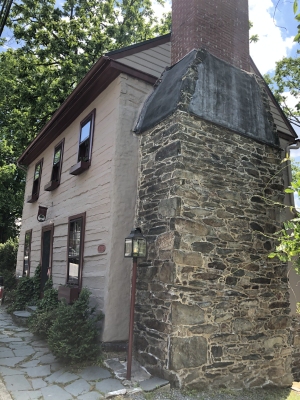
House on Lot 8, Possibly Built by Henry Burkett in 1792 | ||||||||||||||||||||||||||||||||||||||||||||||||||||||||||||||||||||||||||||||||||||||||||||||||||||||||||||||||||||||||
| OPPORTUNITY CREATED | ||||||||||||||||||||||||||||||||||||||||||||||||||||||||||||||||||||||||||||||||||||||||||||||||||||||||||||||||||||||||
|
Had it not been for Joseph Janney developing his land into lots, the Waterford village may not have been established. The village attracted tailors, saddle makers, tavern keepers, cabinet makers, doctors, weavers, and many shopkeepers. Janney did not live to see the village become a town; however, his vision and efforts were key to its development. | ||||||||||||||||||||||||||||||||||||||||||||||||||||||||||||||||||||||||||||||||||||||||||||||||||||||||||||||||||||||||
| ENDNOTES | ||||||||||||||||||||||||||||||||||||||||||||||||||||||||||||||||||||||||||||||||||||||||||||||||||||||||||||||||||||||||
|
[1] Thomas Hague to Joseph Janney, Loudoun
County Deed Book O:9, Lease and Release, May 1, 1781; also U.S., Quaker Meeting
Records, 1681-1935, Pennsylvania, Montgomery, Abington Monthly Meeting, Men’s
Minutes, 1756-1765, as viewed at https://www.ancestry.com/ [2] Mill was owned by Mahlon
Janney, Francis Hague to Mahlon Janney, Loudoun
County Deed Book C:367, June 14, 1762. [3] Abell Janney to Joseph Janney, Loudoun
County Deed Book March 14, 1758. [4] Nicholas Minor to Joseph Janney, Loudoun
County Deed Book A:94, February 17, 1758; Stable reference is in prison bounds
plat, Loudoun County Deed Book D:574, July 4, 1765. [5] Charles Secres,
age 15, bound out to Joseph Janney to learn the trade of cooper, Loudoun County
Order Book G:287, March 15, 1764. [6] Loudoun County Order Book B:672, June 13,
1765. [7] Loudoun County Order Book H:224, April
13, 1784, Loudoun County Order Book L:276, September 15, 1789, as examples. [8] Nicholas Minor to Joseph Janney (lot
#58), Loudoun County Deed Book D:199, May 8, 1764; also, Loudoun County Deed
Book F:43, October 15, 1765 (lot #7) [9] Nicholas Minor to Joseph Janney, Loudoun
County Deed Book F:29, June 6, 1767. [10] John Alexander v Joseph Janney, Loudoun
County Chancery case 1787-009, as viewed at https://www.lva.virginia.gov/chancery/ [11] Loudoun County Order Book F:239, October,
12, 1773 [12] Williams, William, About the Town: A
History, Reprinted in Waterford Perspectives, p. 23. [13] Valentine Peers to Joseph Janney, Fairfax
County Deed Book, May 10, 1784. [14] Joseph Janney and Company, Virginia Journal and Alexandria Advertiser,
October 14, 1784, p. 3. [15] Deed from Joseph Janney, Merchant of the county of Fairfax, to Thomas Moore Junr of Loudoun County, Loudoun County Deed Book O:158, August 17, 1784. Alexandria was then part of Fairfax County. [16] Loudoun County Deed Book O:158, August
17, 1784. [17] Thomas Moore, Jr. trust agreement with
John Sutton, Loudoun County Deed Book O:423, June 17, 1785; Also, John Sutton, Virginia Journal and Alexandria Advertiser, October
20, 1785, p. 4. [18] Farling Ball v
Thomas Moore Jr etc., Loudoun County Chancery Case 1796_002, p. 4, as viewed at
https://www.lva.virginia.gov/chancery/ [19] Mutual Assurance Declaration for
Assurance policy #2143, August 9, 1803, Mutual Assurance Society Microfilm,
3_26_2143, Thomas Balch Library, Leesburg, VA [20] Agclassroom, “A
History of American Agriculture,” last viewed on October 5, 2020, https://web.archive.org/ [21] Farling Ball v
Thomas Moore Jr etc., Loudoun County Chancery Case 1796_002, p. 4, as viewed at
https://www.lva.virginia.gov/chancery/ [22] Federal Census of 1790, Maryland; Also,
Loudoun County Personal Property Tax Ledgers 1790 and 1791. [23] George Emery etc. v. John Sutton, etc.,
Loudoun County Chancery Case 1791_009, pp. 12 and 15, as viewed at https://www.lva.virginia.gov/chancery/; [24] David Lacey vs Thomas Moore & Co,
Loudoun County Chancery Case 1807-003, p. 17, as viewed at https://www.lva.virginia.gov/chancery/ [25] Loudoun County Personal Property Taxes,
1785, 1786, and 1787. [26] Deed from Thomas Moore, Jr. to Asa Moore,
Loudoun County Deed Book Z:307, April 10, 1799. [27] Joseph Janney’s Will, Loudoun County Will
Book D:341, probated October 11, 1793; Loudoun County Land Tax Ledgers:
Alterations 1786, 1787-1799. [28] Deed from Joseph Janney to Richard
Richardson, Loudoun County Deed Book P:338, June 12, 1785. [29] Joseph Janney’s Will, Loudoun County Will
Book D:341, probated October 11, 1793; Loudoun County Land Tax Ledgers:
Alterations 1786, 1787-1799. [30] Cotton, Lee Pelham, “Tanning in the Seventeenth Century,” as viewed at https://www.nps.gov/jame/learn/historyculture/tanning-in-the-seventeenth-century.htm [31] Loudoun County Order Book I:269, July 20,
1786. [32] Loudoun County Order Book M:323,
September 13, 1790. [33] Loudoun County Order Book Q:83, February
9, 1795. [34] Loudoun County Order Book R:273 [35] Loudoun County Historic Court Archives,
Loose Papers, per Indentures Index [36] Loudoun County Order Book W:121 [37] Loudoun County Order Book Z:300 [38] Loudoun County Order Book 1:375 [39] Loudoun County Order Book 4:172 [40] Loudoun County Minute Book 6:307 [41] Loudoun County Minute Book 7:454 [42] Loudoun County Historical Court Index,
Indentures, as viewed at https://lfportal.loudoun.gov/LFPortalInternet/0/edoc/326239/Indentures.pdf [43] James Moore, Virginia Journal and Alexandria Advertiser, February 1, 1787, Vol
IV, Issue 157, p. 1 [44] Loudoun County Land Tax Ledgers
1786-1799. [45] Deed from Thomas Janney to Asa Moore,
Loudoun County Deed Book X:13, January 1, 1796. [46] Thomas Phillips, “Public Sale,” Genius of Liberty, December 16, 1823 as viewed at geneologybank.com [47] “Public Sale,” Genius of Liberty, March 3, 1832, as viewed at geneologybank.com . Ad describes the tannery business of Moore & Phillips that was for sale. [48] Loudoun County Order Book I:87, September
12, 1785. [49] Deed from Joseph Janney to Asa Moore, Loudoun County Deed Book S:320, April 11, 1791. [50] Loudoun County Order Book I:87, September
12, 1785. [51] Loudoun County Order Book I:87, September
12, 1785. [52] Loudoun County Order Book M:323 [53] Loudoun County Order Book N:245 [54] Loudoun County Order Book I:336 [55] Loudoun County Order Book P:321 [56] Loudoun County Order Book O:128 [57] Loudoun County Order Book N:245 [58] Deed from Joseph Janney to Richard
Richardson, Loudoun County Deed Book P:338, June 12, 1785 [59] Deed from Joseph Janney to Joseph Pierpoint, Loudoun County Deed Book P:340, June 12,
1785. [60] Loudoun County Personal Property Taxes [61] Will of Richard Richardson, Frederick
County Maryland Will Book p. 504, July 20, 1802. [62] Loudoun County Land Tax Ledgers, 1787- [63] Fairfax Monthly Meeting Minutes, U.S., Quaker Meeting Records, 1681-1935, Virginia, Loudoun, Marriage, Births, and Burials, January 29, 1795, p. 116, as viewed on Ancestry.com [64] Will of Richard Richardson, Frederick
County Maryland Will Book p. 504, July 20, 1802. [65] Land tax records show Richardson’s estate no longer paying tax on the lot. It is now paid by Moore & Phillips, Loudoun County Land tax ledger 1810. [66] Deed from the Executors of Asa Moore to
Asa Bond for tannery lot. Deed notes store house lot of Moore & Phillips,
Loudoun County Deed Book 4B:89, September 16, 1833. Also, “Public Sale,”
Genius of Liberty, March 3, 1832, as viewed at geneologybank.com [67] “Public Sale,” Genius of Liberty, March 3, 1832, as viewed at geneologybank.com . Ad describes the tannery business of Moore & Phillips that was for sale. [68] In 1858, Asa M Bond acquired the remaining interest of Thomas Phillips in both tanyards, the store house lot, and other adjacent land, Loudoun County Deed Book 5U:333, January 2, 1858. [69] Per Deed from Francis Pierpoint
to Samuel Pierpoint, Loudoun County Deed Book 2K:358,
September 11, 1809; Also, Samuel Pairpoint & Co
[sic] merchant license, Loudoun County Personal Property Tax Ledgers, 1803A [70] Deed from Francis Pierpoint
to Samuel Pierpoint, Loudoun County Deed Book 2K:358,
September 11, 1809. [71] Loudoun County Land Tax Ledgers,
1810-1813. [72] Deed from Joseph Janney to Joseph Pierpoint, Loudoun County Deed Book P:340, June 12, 1785 [73] Deed from Joseph Pierpoint
to Evan Griffith, Loudoun County Deed Book X:262, November 16, 1796; Also, Evan
Griffith Estate Inventory, Values Bar Room Furniture, Loudoun County Will Book
F:164, May 13, 1800; Also, Ordinary License Issued to Evan Griffith, Loudoun
County Personal Property Tax List, 1798A. [74] Loudoun County Land Tax, 1796. [75] Loudoun County Land Tax, 1789. [76] Deed from Joseph Janney to Stephen
Wilson, Fairfax County Deed Book S:325, February 10, 1791; Also, Mutual
Assurance Society Declaration for Assurance, No 2138, Sarah Thompson. House is
described as wooden. Early 20th century photo shows log house. [77] Paxson was still living here in 1791,
Deed from Joseph Janney to Stephen Wilson, Fairfax County Deed Book S:325,
February 10, 1791. [78] Loudoun County Land Tax Ledger, 1786
Alterations [79] It has been reported that the structure
was built using 18th-century rose-head nails. [80] Loudoun County Land Tax Ledger, 1791 [81] Deed from John Janney and John Janney Jr,
executors of Joseph Janney to Andrew Brown, Loudoun County Deed Book X:278,
October 1796. [82] Metes and Bounds in deed from Joseph
Janney’s heirs to John Williams mentions Ann Myers’s lot. Loudoun County Deed
Book 2C:21, April 14, 1794. [83] Joseph Janney heirs to John Williams, Loudoun County Deed Book 2C:21, April 14, 1794. [84] Loudoun County Deed Book U:170, prepared February 16, 1792 and recorded October 8, 1792. Plat was recorded at the request of Asa Moore. [85] Lease from Joseph Janney to Henry Burkett, Lots 7 and 8, Loudoun County Deed Book U:266, June 1, 1792. [86] Loudoun County Personal Property Tax Ledgers, 1789-1791. [87] Loudoun County Order Book P:321. [88] Loudoun County Personal Property Tax Ledgers, 1794-1796. |

| Home |
 |
| © Debbie Robison, unless otherwise noted. All rights reserved. |